M. Isidora Forrest's Blog, page 17
November 13, 2022
The Awe-full-ness of the Goddess
 From the Goddess Power Oracle.
From the Goddess Power Oracle.Not too long ago, I came across a collection of epithets of Isis in which the author translated the core concept as “awful.” What?
But, in the original sense of the word, “full of awe,” awful makes a great deal of sense as a Divine epithet. Nevertheless, in our common understanding of the word today, it’s…oh, let’s say…uncomfortable.
So you can get a full taste of the strangeness of it, here are some of Isis’ awful epithets: She is “The Lady of Awfulness,” “The Lady of Awfulness More than the Divine Powers,” “She Whose Awfulness is Great,” and “She Whose Awfulness is Greater than the Gods.” She is awful on earth, in the heavens, among the Deities, in Egypt. She is “Great of Trembling” and “Hundreds of Thousands Tremble at Her Sight.”
Of course, this is not the most common way people think of, or experience, Isis. Most first encounter Her as a kindly mother, protective, guiding, and gentle.
And She is.

An awe-some Isis by Ugo Sirius. Find more of his work here.
But sometimes, the Goddess inspires deep awe. Sometimes, in Isis’ presence, an electric shudder runs up your spine and your hair stands on end and you look into the unending depths of Eternity and you are struck speechless with wonder and some strange and peculiar aspect of fear. Holy awe is the only name by which I can name it.
And She is sometimes like that. So today, let’s talk about the awe-full-ness of Isis.
 Eternity looks back
Eternity looks backThe ancient Egyptian word translated as “awful” in the epithets above is transliterated nrw. To be able to pronounce it, we go with neru. It is associated with the vulture and with Isis and Nephthys as the two Vulture Goddesses, the Nerti. (You may recall that the word for vulture in Egyptian is mut, that is, mother. And so the gentle Mother Goddess meets up with the fierce Mother Goddess and perhaps we are no longer left wondering about this awe-full Isis.)
The ner root of the word neru means to be strong, to be mighty, to terrify, to strike awe, to be victorious. Neru can be The Terrible One…or the concept of strength, might, or victory. It can also be fear or dread. Neri can be to over-awe. There is a Goddess of Strength called Nerit. And ner also can have connotations of protection because of the Awful One’s strength and might and power to protect. So, I guess, “awful” may be a pretty good translation of the idea.
Iset Nerit is Isis Who Strikes Awe.*
 Priestess by artofsago
Priestess by artofsagoIf you are just beginning your relationship with Isis, it is likely that you haven’t met Iset Nerit yet. Ah, but She is always there. For instance, She may come to you disguised as Isis the Ass Kicker. Or She may give you a glimpse of Her fierceness or Her fire. As the Goddess of Magic, She is the wielder of the First Power, the Power upon which All Things depend. It is, rightfully, an awesome power.
When Isis is at Her Most Primordial, Most Ancient, Most—ENORMOUS—that is when we are greeting Iset Nerit. In Her presence, my belly thrills, I shudder with ecstatic and holy fear. The numinous, the sacred, the strange, and the powerful is with me, before me, around me. I kneel and kiss the ground before Her beautiful face.
For some, this experience may be unsettling. I am reminded of some folks of my acquaintance who apparently thought we were just playing at magic, role-playing with the Deities. Then magic actually happened. And the Goddess was really there. And they were done.
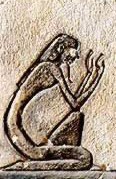
When we’re in the early days of a relationship with Isis, it is probably best not to seek out Iset Nerit. She will appear to us when She is ready and when we are ready. (Unless, of course, we particularly like that feeling of holy fright before the Divine; some of us do, she admits sheepishly.)
What about you? Have you experienced the Presence of Isis in the full power and puissance of Her Awe-full-ness?
*For Coptic fans, Nerit is Noure (noor-ray), which is rather beautiful in the same soft way that Coptic Ise (Ee-say) is: Ise Noure. Say it soft and it’s almost like praying.
November 6, 2022
Isis Pelagia, Lady of the Sea
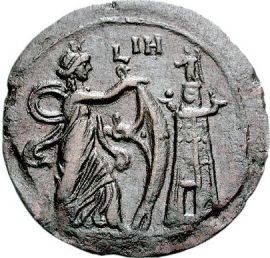 Isis Pharia with Her sail and the lighthouse an Alexandrian coin
Isis Pharia with Her sail and the lighthouse an Alexandrian coinThroughout the ancient Mediterranean world—from Alexandria to Carthage, from the Roman port of Ostia to Corinth, and on to Palmyra in Asia Minor—in locations dotting the shores of the Black Sea and the riverbanks of what is now Hungary, we find a particular image of Isis.
She stands on the prow of a ship, holding a billowing sail in front of Her, wind filling it from behind. And yet Her own garments flow out behind Her, filled with the wind produced by Her forward momentum. Trying to be precise, if dull, in their description, archeologists simply call this image “Isis with a Sail.” But those who created these images, on gems, coins, lamps, carved reliefs, and statues, would have called Her by a different title. They might have named Her Isis Pelagia, Isis of the Seas. Or Isis Euploia, Isis of Good Sailing. Or, most commonly, Isis Pharia.
 Isis Pharia, Her sail sadly broken off
Isis Pharia, Her sail sadly broken offAs Pharia, Isis is connected with the great lighthouse of Alexandria, one of the Seven Wonders of the Ancient World and a famous symbol of the city of Alexandria. The lighthouse was called the Pharos after the small island on which it stood. Due to the lighthouse’s fame, pharos eventually became a general term for “lighthouse.” (This persists even in modern languages; in Italian and Spanish, lighthouse is faro and in French, it is phare.) Isis Pharia is Isis the Lighthouse Goddess.
As you can probably deduce, all these epithets are Greek, the common language of the time. In the Illiad, Homer uses the word pharos for any large piece of fabric, including a ship’s sail. Which connects this most-common sea-related epithet for the Goddess both with Her illuminating lighthouse and Her billowing sail—as we see on the image of the Alexandrian coin above.
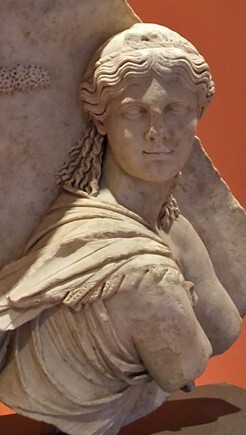 Isis Pelagia, Roman, photo by Ann Raia
Isis Pelagia, Roman, photo by Ann RaiaI’m writing about Pharia today because I have to return an interlibrary loan of Isis Pelagia: images, names, and cults of a goddess of the seas. So I have to take my notes before returning. The book isn’t quite as interesting as it sounds and I didn’t discover too much new about Our Lady in it. Nonetheless, I thought I’d share what I did find. You might find it of interest, too.
 Isis departing from Byblos on Her ship after finding the body of Osiris
Isis departing from Byblos on Her ship after finding the body of OsirisSince most of ancient Egypt was concerned with the Nile and not the sea, in Egypt, Isis is a Goddess of the Waters through Her connection with the Nile flood, the Inundation. As Iset-Sopdet, Isis-Sothis, She calls the life-giving waters to rise and fertilize the land of Egypt. She is also connected with the Nun, the Primordial Waters. An inscription on a 2nd century BCE temple calls Her “She at the Head of the Life in Nun.” At Philae She is the Lady of the Whole Nun for it is in the Nun that the Inundation has its source. At Hathor’s Ptolemaic-era temple of Denderah, we also find Isis connected with the sacred lake or isheru. At Denderah, She is specifically called Lady of the Seas. Isis is associated with boats and navigation in Her roles guiding the divine boats of the Deities in the otherworld. And in some tales, Her search for Osiris is taken by boat. She is also a Goddess of the winds, critical for travel by ship. Isis also picked up even stronger sea connections as She became more and more assimilated with Hathor and Aphrodite.
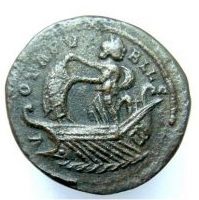 Isis on Her ship with sail
Isis on Her ship with sailAll this is to say that it wasn’t out of nowhere that the image of Isis Pharia came to some prominence throughout the Mediterranean world. We find Her in port cities, billowing cloak and full-bellied sail, protecting ports and sailors, a savior on rough seas. Further, it is no great stretch to find Her as a savior of souls, a harbor against the fear of death, as we discover Her in Apuleius’ tale of initiation into Her Mysteries and an account of Her famous festival the Navigium Isidis.
The most interesting new things I found in my borrowed book have to do with the cult for Isis of the Seas. Those of us who would want to honor Her in this form might find them of use.
Ritual practices
Generally, services in the temples and shrines of Isis Pharia would have been similar to the regular services: praises, offerings, dressing the sacred image. But we do have an account of some specific offerings made to Isis of the Sea. A man named Damis believed She had saved him from drowning. In thanks, he offered Her a crumbly cake, a pair of white “water-dwelling geese,” figs, raisins, and frankincense.
 A boat-shaped votive lamp with Isis, Serapis, and Harpokrates
A boat-shaped votive lamp with Isis, Serapis, and HarpokratesA somewhat unusual offering seems to have been a votive painting, either in thanks or as a request for saving at sea. We know of the practice because the Roman satirical poet Juvenal mocked it, joking in effect, “who knew that Isis also nourishes painters?” Some scholars have suggested that those who had come safely through a sea voyage would dedicate their hair to Isis of the Sea, though this is not fully confirmed.
Before a sea journey, people might dedicate small images of Isis with a Sail in one of Her shrines or temples. We also have examples of small votive objects shaped like an anchor dedicated to Her. Some of these were small enough that they could be drilled at the top and worn as an amulet. We have one of these drilled amulets that includes an image of the Goddess as a serpent crowned with Her characteristic basileion headdress. People would also turn coins with Her image on them into amuletic jewelry—rings or pendants—to wear for protection at sea. There are many examples of boat-shaped oil lamps that were offered to both Isis and Serapis, Who had His own marine form.
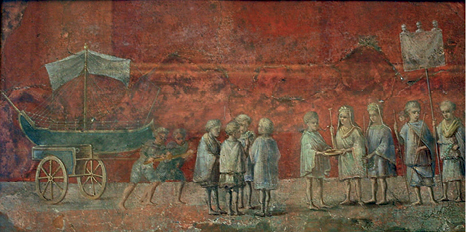 A painting from Ostia of (possibly) the Navigium Isidis
A painting from Ostia of (possibly) the Navigium IsidisFestivals of Pharia
You’re already familiar with the Navigium Isidis, the festival of the Navigation of Isis or the Ship of Isis, which marked the opening of the sailing season in the Mediterranean. So I’ll leave any additional details on that for another time. This next festival is one I hadn’t known about.
A Roman calendar known as the Chronology of 354 (CE) records the festival of the Sacrum Phariae on April 25th. The April 25th date would have corresponded to the Alexandrian Egyptian date of the day before 1 Pachon, when an important Egyptian harvest festival was celebrated. The evidence we have this festival is pretty sketchy, but it may be that the Sacrum Phariae welcomed the all-important shipment of grain from Egypt to Rome under the protection of Isis Pharia.
 Modern Ukranian grain ship
Modern Ukranian grain shipIf we were to create our own version of the Sacrum Phariae, we might have to go pretty far afield from the original to make a rite that would be meaningful to us now. Perhaps a Lammas rite?
We, of course, have no shipments of grain from Egypt to celebrate. And yet this ancient festival is not without relevance for people today. At this very moment, in the Black Sea, grain ships from Ukraine are bringing much-needed shipments of wheat, barley, sunflower oil, and other foods to ports in Africa, the Middle East, and parts of Asia. Yes, this includes Egypt. For instead of being one of the bread baskets of the ancient world, modern Egypt is instead the world’s number one importer of wheat.
So today, I offer prayers to Isis Pharia for the safe and swift delivery of the grain ships that are helping to feed the world. As these ship sail across the Black Sea, they will likely pass by the sites of ancient ports where images of Isis with a Sail have been found. Her presence is there as it is in our hearts. Amma, Iset.
October 30, 2022
Isis Magic almost out of print, oh my!

Not sure I ever thought this day would come, but come it has.
There are less than 100 copies of Isis Magic left. After those are sold, the second edition of Isis Magic, like the first edition, will be out of print. So if you’d like a copy, a new copy, or are thinking of Yuletide gift-giving, now is the time to order.
We’ll have to figure out what happens after that. We may go to some kind of print-on-demand option. But that will take research; there are actually quite a few considerations with going that way. Nothing will happen quickly, but I’ll keep you in the loop.
Thank you all for your support of Isis Magic. I am honored and humbled that so many of you have found it of value on your personal path with Our Lady, the Great Goddess Isis. And it gives me great joy that there are so many of us discovering or re-discovering Her.
There WILL be a new, updated edition of Offering to Isis, Knowing the Goddess through Her Sacred Symbols coming out sometime in 2023. Details to come as soon as I have them. Yay!
I think Offering is an under-rated book. It has lots of good info and a variety of ways to make offering to Her. But when it was previously published, it fell between the publicity cracks at the publisher so not many people discovered it.
I am thrilled that it will be coming out in a new and updated edition. Finally.
October 23, 2022
Nephthys & Osiris?
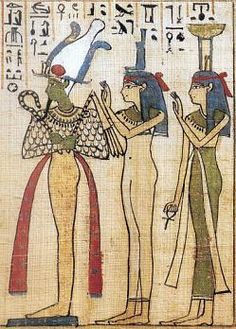 Osiris, Isis & Nephthys
Osiris, Isis & NephthysI’m reading an interesting paper on the Egyptian evidence we have/don’t have of the alleged affair between Nephthys and Osiris. And I thought I’d share.
The only actual statement about the affair comes from Plutarch’s account of the Isis and Osiris myth in his essay “On Isis & Osiris.”
As you may recall, Plutarch was a prolific writer and a Greek priest at Delphi. He traveled to Alexandria, which is probably where he got his Egyptian information. Reading his essay, it seems like he got a lot of the Egyptian details correct, though it is all filtered through his Middle Platonic philosophical lens. He’s writing in the 2nd century CE, too, by which time there was a lot of mixing of religious thought, especially in Alexandria. What’s more, the 2nd century CE was also the time of Isis’ greatest influence in the Mediterranean civilizations…so a lot of people were interested in Her and the Deities around Her. Yet Plutarch got his info from somewhere, so there must have been a tradition about it, at least in some nome or another.
Anyway, here’s his account of the Osiris/Nephthys affair:
They relate also that Isis, learning that Osiris in his love had consorted with her sister through ignorance, in the belief that she was Isis, and seeing the proof of this in the garland of melilote which he had left with Nephthys, sought to find the child; for the mother, immediately after its birth, had exposed it because of her fear of Typhon. And when the child had been found, after great toil and trouble, with the help of dogs which led Isis to it, it was brought up and became her guardian and attendant, receiving the name of Anubis, and it is said to protect the gods just as dogs protect men.
Plutarch, On Isis & Osiris, section 14
 Common melilote; it also comes in white and purple; it is a healing herb, too
Common melilote; it also comes in white and purple; it is a healing herb, tooThat’s it. We are left to guess how this all came about? In more human terms, we might wonder whether Nephthys intentionally deceived Osiris? Or was Osiris really that blind, really? Some scholars have proposed this incident as the reason Set murdered His brother Osiris, rather than His desire to rule in Osiris’ place.
In a text called The Book of Overthrowing Set, a magical text for weakening Set’s power, a threatening spell tells Set that His wife (the text does not name Her, so in no way are we sure Nephthys is meant) is raped in front of His eyes and there’s nothing He can do about it. (As an aside, for some damn reason I have been seeing far too much about raped Goddesses recently and I am about Up. To. Here. With That Bullshit. Calling raging Sakhmet now!)
 This is kinda THE statue of Nephthys and Set
This is kinda THE statue of Nephthys and SetWe find Nephthys and Set paired in several key places. For instance, the Pyramid Texts instruct Nephthys and Set to proclaim the good news of the king’s rebirth in Upper Egypt, while Isis and Osiris are to proclaim it in Lower Egypt. At least one statue of the pair exists.
And in one pretty crude magical text from the Ptolemaic period, we have Set, in the form of an ass, complaining that He was interrupted while mounting Nephthys, “the female donkey.”
Voice of Seth: [The] female donkey was taken, when I was seizing her tail. I was given deceit … Nephthys was taken, when I was on her anus … although she belongs to me as a wife.
Berlin papyrus 8278b
 Set with ass’ head from a magical papyrus
Set with ass’ head from a magical papyrusAnd we also find both Deities with temples in the complex at Sepermeru in the Upper Egyptian nome of Oxyrhynchus. Since Sepermeru means “near to the desert,” it was an apt place for a temple of Set, Who is both attuned to and a bulwark against the perils of the desert. There’s also a passage in a ritual that may show us Nephthy’s care for Set. In the rite, Set has been killed and the Deities are rejoicing, all except Nephthys, Who instead dons a veil of mourning.
Yet all is not settled in Set’s and Nephthy’s world. In part of a ritual text, Nephthys reminds Horus of the danger She undertook for His sake—presumably danger from Set. She reminds Him that She left the “son of Set” to care for Him, Horus. In yet another text, Nephthys says of Herself, “I acted as a partner in deception. I destroyed the fortress of Seth.” But still, She is the only Deity Who mourns Set’s death.
So Nephthys and Set, definitely connected, if rockily so. How about Nephthys and Osiris?
 Anubis, son of Osiris
Anubis, son of OsirisAccording to our Greek Priest, Osiris and Nephthys slept together and, as is the way with Deities, Nephthys became pregnant with Anubis. In fear of Set, She exposed the child, Who was searched for, found, and reared by Isis, thus becoming Her loyal companion. (As an aside, Egyptians didn’t generally expose unwanted children; this was more known in Greek communities.)
 The weirdest Anubis ever. This is a Roman version of the God as He was seen in some Roman temples
The weirdest Anubis ever. This is a Roman version of the God as He was seen in some Roman templesYet here’s some interesting stuff. Yes, Anubis is indeed said to be a son of Osiris, mostly in Ptolemaic texts. At Isis’ temple at Isiopolis (Lower Egypt), Horus and Anubis were joined as Horus-Anubis and called the Son of Osiris. The Sicilian writer, Diodorus, wrote that Osiris has two sons, “one Who wears a dog’s skin” and the other called Macedon. Yet some scholars consider Anubis to be more an adopted son of Osiris, rather than a “son of His body.”
The closest thing we have to a Nephthys-Anubis connection is from a late-period papyrus known as the Papyrus Jumilhac that says, “Nephthys, Her bravery existed with Him [Horus], She had Him [Horus] hidden as a small child in papyrus, His name is Anubis and His image is as Mehit-imyut.” So, here we have Nephthys hiding the baby Horus, Who is also Anubis. Is Nephthys hiding Her own baby Horus-Anubis just as Isis hid Her baby Horus? Or is Nephthys simply helping Her sister, as She so often does?
 A Roman altar dedicated to Isis, with Anubis on one side
A Roman altar dedicated to Isis, with Anubis on one sideEven more intriguing, in Egyptian texts, it is Isis Who is named as Anubis’ mother rather than Nephthys. We have a good handful of texts, particularly from a later period, that specifically name Isis as His mother. For instance, the Jumilhac papyrus brings us a reference to “Horus the child, Who is in this place, it is Anubis, son of Osiris, when He was an august child in the arms of His mother Isis.”
Plus, we see evidence of the Isis-Anubis connection in Greek and Roman Isis shrines and temples, where Anubis is included as the fourth Egyptian Deity worshiped with Isis, Sarapis, and Harpokrates. And just to make things more complicated (as they so often are), other texts identify Anubis as a son of other Goddesses, such as Neith and Bastet. But, in fact, currently we have no Egyptian texts that name Nephthys as Anubis’ mother either by Set or Osiris. That doesn’t mean there weren’t any; just that we don’t, at present, have them. And, like I said, Plutarch got his info somewhere.
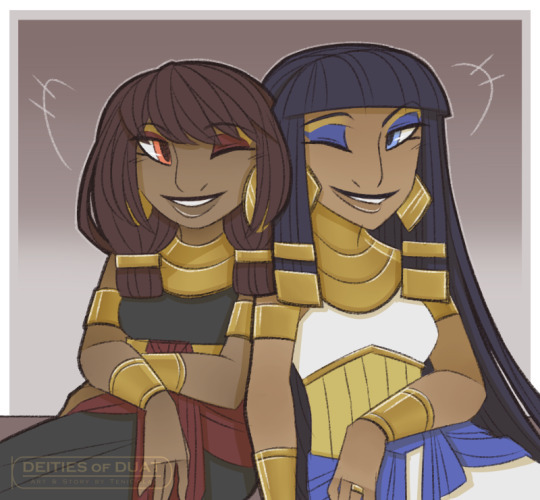 I swear, this is how I see Them
I swear, this is how I see ThemOkay. So there’s one more thing I would like to address regarding Nephthys and Her possible motherhood of Anubis. There is a particular passage often cited by scholars in relation to this topic, which says Nephthys, when She comes “in Her evil coming,” is called “imitation woman who has no vagina.” They cite this passage as evidence that Nephthys was barren.
But no. This passage is from a group of Pyramid Texts that describe a selection of Deities “in Their evil coming.” If anything, Their evil coming would be the exact opposite of Their usual coming. In this particular Pyramid Text, we have the “evil comings” of Osiris, Horus, Thoth, Set, Isis, Nephthys, and more. Isis, for instance, is said to be “extensively corrupt.” These texts mean absolutely nothing in terms of defining the nature of any of those Deities. So, in my somewhat-but-not-entirely humble opinion, we can fully ignore this as any kind of evidence that Nephthys could not bear a child.
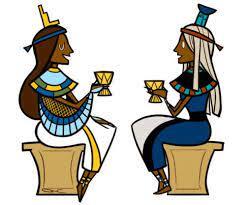 The Two Sisters
The Two SistersOther than Plutarch’s Greek account, the only source from Egypt that we have about Osiris and Nephthys is from a 4th century CE erotic spell written mostly in Greek with some Old Coptic passages. The spell uses a historiola—the telling of a myth within the spell—to empower it. In the spell, Isis comes crying to Thoth that Nephthys and Osiris are sleeping together. Thoth proceeds to instruct Her on the correct spell to use to get Osiris back…and which, of course, we humans can use in similar circumstances.
Other than that quite-late spell, there’s one pretty obscure Book of the Dead mention that might relate to such an incident, though it is not certain. In it, Thoth “makes the Two Sisters friendly toward Osiris,” yet it’s in a list of all kinds of things that Thoth has made good for Osiris.
In Plutarch’s telling, Isis seems pretty blasé about the whole thing and calmly goes in search of Anubis. Perhaps it’s because the Two Sisters are so close that it doesn’t really matter. From the earliest Egyptian texts we have, the Pyramid Texts, we see Isis and Nephthys doubling each other. Some texts inform the king that Isis conceives him and Nephthys bears him. (This is true of other pairs of Goddesses, too; one conceives and one bears.) To me, this is yet another example of the exquisite fluidity of ancient Egyptian Divinity. The Sisters are One, yet not One. They are Two, yet not Two. Here’s a post about the entwined and twinned nature of Isis and Nephthys.
 Iseneththys aiding in the resurrection of Osiris
Iseneththys aiding in the resurrection of OsirisOne scholar has suggested that Isis was intended as Osiris’ companion in the upperworld and Nephthys in the underworld. For me, the idea doesn’t ring true. Isis also has deep, deep underworld connections and we are told that Osiris rejoices when He sees Her there. And Nephthys, especially as Lady of Joy, has many and varied upperworld functions; She is not just associated with the land of the dead. The sisterly situation is not that black-and-white.
Of course, even outside of any sexual liaison, Nephthys and Osiris share an important connection. They are siblings, just as Isis and Osiris are. Nephthys searches for Osiris, too. She laments Him. She protects Him. She loves Him.
So what do we make of all this? Nothing? Anything? One thing we can say for sure is that It’s Complicated. We clearly don’t have anything definitive from Egyptian sources that are currently available to us. In fact, the scholar who’s paper I’m reading concludes that there simply isn’t any evidence to convict Nephthys and Osiris of adultery and declares Them innocent.
For my part, I’m going to guess that there was a genuine Egyptian tradition of Osiris with Nephthys. But for me, it is part of the Mystery of the Two Sisters. They share so much. Why might They not share a Beloved One as well?
 The most beautiful “Osiris Rising” image I know. He is lying on His stomach and as He revives, His head rises up. I got to see this sacred image in person when an Egyptian exhibition came to Portland some years ago.
The most beautiful “Osiris Rising” image I know. He is lying on His stomach and as He revives, His head rises up. I got to see this sacred image in person when an Egyptian exhibition came to Portland some years ago.
October 19, 2022
Oracle of Luna podcast
 Love Her beautiful feet in this pic!
Love Her beautiful feet in this pic!Mid-week mini-post!
I so enjoyed talking with Bridget Engels of the Oracle of Luna podcast about (I’m sure you are all so very, very surprised) Our Lady Isis. The podcast is available now, if you’d like to have a listen and join our chat.
Bridget comments, “Here we explore this most worshiped and ancient of Egyptian Goddesses. We discuss Isis’ history and Her many aspects that have kept Her relevant for centuries and well into the future. As an all encompassing cosmic Goddess, Isis has many divine and human aspects worthy of connecting and developing a sacred devotional relationship with. Isidora has been a devotee to the Goddess Isis for over 25 years. Her phenomenal book will open the doors of your mind and spirit to discover and become enlightened yourself to Isis’ immense power and wisdom!”
You can find the Oracle of Luna on Spotify and on Apple podcasts.
Enjoy!
October 16, 2022
Is tradition important in the worship of Isis?
 Part of my shrine for Her; traditional-ish
Part of my shrine for Her; traditional-ishAs is so often the case, it depends on who you ask.
Folks who are trying to reconstruct a form of ancient practice will, of course, find it very important. Others who are attracted to Isis, but not necessarily the entire ancient Egyptian milieu, might find it less so.
For me, there isn’t a yes-or-no answer to this question; rather, there’s a yes-and-no answer.
Yes, Tradition is Very Important
Without tradition, where do we even begin to think about Isis? How can we know Who She is for us if we don’t know Who She was for those who went before us? Without tradition, we have nowhere to begin as we try to come into relationship with Her. Without a knowledge of the symbols traditionally associated with Her, the stories traditionally told about Her (at least the ones of which we have records), how do we know we’re contacting Isis rather than a more generic Divine Feminine?
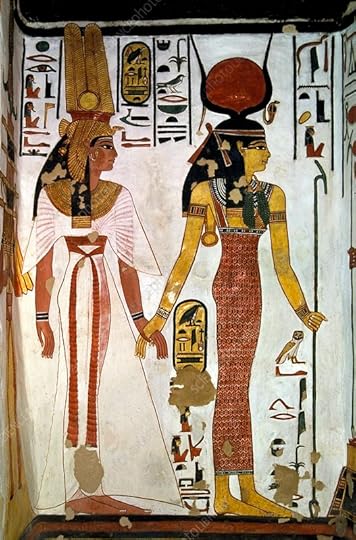 Tradition can lead us as Isis leads the queen
Tradition can lead us as Isis leads the queenIndeed, we may feel truly called to Isis as Isis—even without indepth study of ancient Egyptian religion and traditions. But then what do we do? How can we honor the Goddess Who calls us in a way that is most pleasing to Her? How can we honor Her in a way that will help us succeed in our heart’s desire of coming to know Her?
Tradition is our savior in this.
Tradition provides the deep roots of our worship. It gives us an anchor for our modern love of Isis. Suddenly, we have a way to feel close to Her. We can learn and interpret Her myths. We can give Her the offerings that were traditionally given to Her. If we are of a scholarly bent, we might learn a bit about hieroglyphs so that we might write Her name in the ancient ways. We can use excerpts from the ancient Egyptian sacred texts in our rites.
With Isis, we are blessed for there is a wealth of information available about Her, online and off. And its growing all the time. Those of you who know me also know that our house if full of books. Books are our friends. Scholars who never worshiped the Goddess, but who have done the research Isis worshipers need, are our friends. If you’re a crazy Isiac like me, interlibrary loan is your friend (and for free, too). Academia.edu can be good (even the free version) as can scribd.com (which is a paid service).
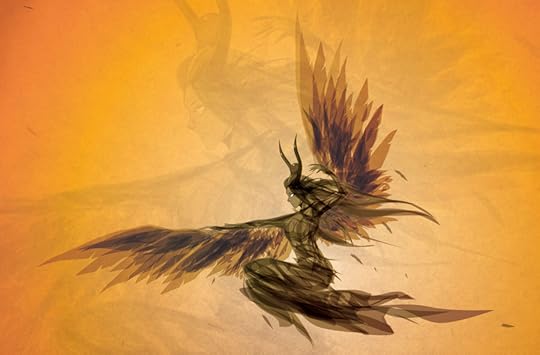 A modern, rather witchy Isis by Chasing Artwork
A modern, rather witchy Isis by Chasing ArtworkLearning about Isis’ ancient worship, Her history, and the way Her devotees thought about Her connects us to our chosen past. It connects us to our chosen Goddess.
But Maybe Not So Much?
But I strongly believe that tradition should not constrain us. Ancient rites are not Her only rites. Tradition provides the anchor and the roots, not the sails and the flowers. Thousands of years have passed since Isis’ name was first spoken in praise by human beings. We have changed. We shall continue to change. And that means that our experience of the Goddess can never be exactly the same as Her ancient devotees. One thing we learn from our study is that Her Divine expression changed over time. So while our understanding of the Goddess begins with the roots of tradition, it continues with the flowering of our own experience of Her.
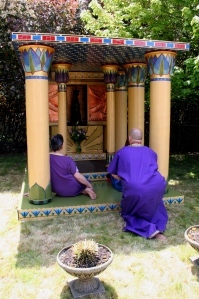 We hold Isis in our hearts today; as She holds us.
We hold Isis in our hearts today; as She holds us.She may show us new symbols that pertain to Her. (For instance, I think there is very good reason to consider Isis as the Digital Goddess and Isis Technologia.) We may not be content to only recite the ancient sacred texts, but wish to write our own heartfelt ones. Many, many are the Isiacs who have expressed their modern understanding of the Goddess in new poetry or prose or prayer or ritual or art.
So I guess, as usual, my answer is “both-and,” not “either-or.” This is a more difficult—because more ambiguous—answer. Yet for me, it is the more truthful answer. We need both tradition and innovation. If we are to be Her devotees, then we need to know about Her past. We need to both create and be Her present. And when we do, we will carry Her love and Her power and Her wisdom and Her magic forward, into tomorrow.
October 9, 2022
Isis & Wine
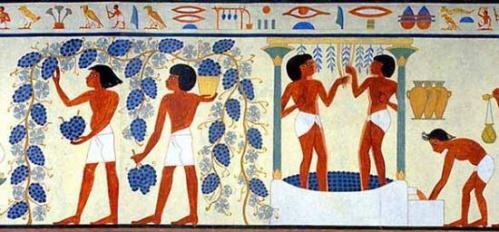 Egyptian grape harvest and winemaking
Egyptian grape harvest and winemakingAs it turns out, both my Deities are Wine Deities. Although my sweet mad Dionysos is more known for His wine-y associations, Isis too, is connected with wine. And since it is grape harvest time here in the Pacific Northwest, I give you a bit about Herself and the vine…
 Isis chardonnay from Malta
Isis chardonnay from MaltaThe grapevine is not native to Egypt, but by the early third dynasty, Egypt had a viticulture industry all its own. Still, wine was expensive and it was generally reserved for the wealthy and priestly classes, for tomb offerings, and for the Goddesses and Gods. The Egyptians made both red and white wines; a Greek writer commented quite favorably on the quality of Egyptian white wine. Due to its Mediterranean climate and the greater availability of water, most ancient Egyptian vineyards were located in the Nile delta…though it turns out that Isis’ temple at Philae owned a vineyard, too.
Several delta cities had a reputation for their fine wines, including Sebennytos, the town near Isis’ great temple at Isiopolis. It was common for temples to have their own vineyards (see Philae above). There was even a tradition in Egypt that, on occasion, the water of the Nile turned to wine. Epiphanius, the early Christian polemic writer, tells us that many people attested to this Nile-water-into-wine miracle. Of course to Epiphanius it was a Christian miracle, taking place on the 6th of January and commemorating Jesus’ water-into-wine miracle.
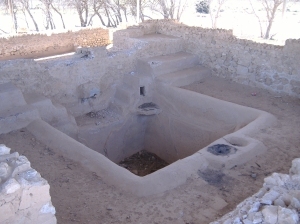 An Egyptian winepress
An Egyptian winepressThe Goddesses Hathor and Bastet are both associated with wine and beer, especially during Their Festivals of Intoxication where imbibing was part of the worship. The Winepress God, Seshmu, is also known from the funerary texts. He brings grape juice to the king for wine production, gives wine to the deceased—and crushes the heads of enemies and wrongdoers in His bloodthirsty winepress.
Yet if there is one Egyptian Deity Who has the most right to the title of God of Wine, it is Osiris, the husband of Isis. Osiris is known as Lord of Wine as early as the Pyramid Texts and His identity as such only grew as time passed. In a magical papyrus from the second century CE, the “blood of Osiris,” clearly wine, is poured into a wine cup, and is to be given to a woman as part of an erotic spell: “Give it, the blood of Osiris, that he gave to Isis to make her feel love in her heart for him night and day at any time, there not being time of deficiency.”
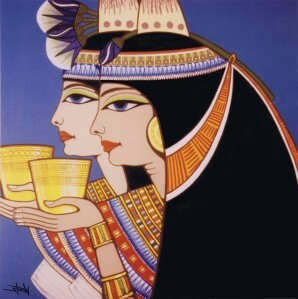 Noble ladies enjoying their wine
Noble ladies enjoying their wineNo doubt, the association of Osiris with wine is the reason that one story tells us that Isis became pregnant with Horus by eating grapes. Isis Herself is also given the epithet Mistress of Wine and Beer.
In addition to Her marriage to the Lord of Wine, Isis has Her own associations with the vine and with the Greek Wine God Dionysos. The Greeks considered the sacred star of Isis, Sirius, to be the bringer of wine since its late-summer rising coincided with the beginning of the harvest season. Ancient writers also speculated on a variety of Isis-Dionysos connections. One said that Dionysos is the son of Zeus and Isis. Another called Isis the daughter of Prometheus and said that She lived with Dionysos.
 The Ebers Papyrus begins with a prayer to Isis, Great of Magic
The Ebers Papyrus begins with a prayer to Isis, Great of MagicWine can also be associated with Isis as a Healing Goddess. Wine and beer were the delivery media for many an ancient remedy. Ancient medicines often listed a variety of herbal ingredients to be put into wine, then the patient was to drink the potion for a particular number of days. And, of course, as Goddess of Magic, Isis is often part of the cure for “Magic is effective together with medicine. Medicine is effective together with magic,” according to the Ebers medical papyrus. The papyrus even begins with a prayer to Isis, Great of Magic.
As for other Deities, wine was a common offering to Isis. Due to its costliness, it was a valuable offering, but wine was also thought to temper the sometimes-fierce nature of the Goddess. For, like Hathor and Sakhmet, Isis could be offered wine to “make Her heart rejoice” so that She would not be angry. Temples of Isis in Egypt and even further afield bear evidence of offerings of wine. Isis’ temple at Philae has wine-offering scenes carved on every doorway lintel down the central axis of the temple, as well as in side sanctuaries and on exterior walls.
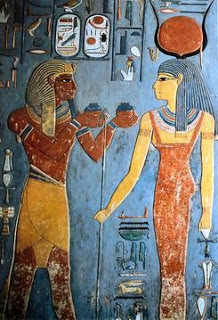 Offering wine to Isis
Offering wine to IsisA wine cup dated to 73 CE was found in a shrine of Isis on the island of Paos in the Aegean and includes an inscription to “Isis the Great.” An ancient Roman wine jug discovered in Southwark, England has an inscription that reads: Londini ad Fanum Isidis (“to the Temple of Isis in London”).
Wine vessels are included in the Roman Isis procession described by Apuleius, yet candidates for initiation into the Mysteries of Isis had to refrain from drinking wine for ten days before an initiation.
Isis, the Mistress of Wine, is married to Osiris, Lord of Wine, and Their Holy Child is conceived by the consumption of grapes. And so our Lady is both the green Goddess of the vine and the purple Goddess of the wine.
October 2, 2022
Being Divine
 “I am Isis”
“I am Isis”Almost all the magical people I know agree that we are in a time of change. What we are transitioning to, we cannot be sure. It can be frightening, exciting, confusing, hopeful.
It is also a very good time for magic. Why?
Because it is in times of flux that magic has its best chance of having an outsized effect. For example, weather magic works best when the weather is actively changing. A magical push here or there can help create the outcome we desire. Timing is important.
In ancient Egyptian myth, Creation comes forth from out of the unformed, chaotic, primordial Waters, the Nun. When things are changing, when they’re a bit chaotic, heka can enable us to grab a bit of that chaos and turn it into cosmos, Order. (Some scholars think the name of the Egyptian Magic God, Heka, means “He who pushes the ka.” This seems to me a very good description of how—at least some, perhaps a majority—of magic works. A push here or there in the right direction.)
One of the techniques we can use for our own ka-pushing is a technique I believe is THE key to Egyptian magic. It has no known Egyptian name, but you find it everywhere throughout Egyptian sacred written materials. It freaked out the Greeks when they learned about it from Egypt. And it still freaks out some modern magic workers.
Here, let me demonstrate it:
I am Isis. I have gone forth from my house and my boat is at the mooring rope… O you who travel in the sky, I will row him with you, I will travel as Isis.
My name is Isis in the Sealed Place; I am in my name and my name is a god; I will not forget it, this name of mine.
I am Isis when she was in Chemmis, and I will listen like him who was deaf and who stared.
Go behind me for I am Isis!
Excerpts from the Coffin Texts
These excerpts from the ancient Egyptian Coffin Texts show the technique precisely. Of course, those texts can often be a bit obscure. Here’s another example of the technique in a modern Neo-Pagan/Witchcraft/Wiccan context:
Cool moonlight streams into the Circle, falls upon the altar, glitters the silver jewelry upon the breast of the High Priestess. Her eyes are closed. Her arms and legs are flung wide—as if she would abandon her body by sheer human desire. She feels her heart radically alive. She breathes softly and deeply, praying in silence for the Goddess to come, to come.
Before her, the High Priest kneels, “I invoke Thee and call Thee, Mighty Mother of us all, By seed and root, by bud and stem, by leaf and flower and fruit, by life and love do I invoke Thee to descend upon this Thy servant and Priestess!”
The witches begin a low humming as the High Priest continues to invoke the Moon Goddess by Her many names, asking Her, praying Her to descend—now! now!—into the body of Her Priestess.
 Thessalian witches Drawing Down the Moon
Thessalian witches Drawing Down the Moon
Then a sharp intake of breath. The High Priestess’ breathing has become ragged. Moonlight catches in her hair, illuminates her body. An electric thrill runs up her spine. The nape of her neck prickles with spirit fire. Her hair stands on end. Her dark eyes snap open, staring strangely. The atmosphere within the Circle is changed. Every one of us feels it. Excitement in the pit of the stomach. Anticipation. Truth.
The High Priestess looks into our eyes, into our hearts, and begins to speak the Charge of the Goddess, “Whenever you have need of anything, once in the month, and better it be when the moon is full, then shall you assemble in some secret place to adore the spirit of Me, Who am Queen of all the Witches…”
We have Drawn Down the Moon. The woman who was our High Priestess is—for this brief and sacred moment—the Goddess incarnate. And She gives us Her blessings.
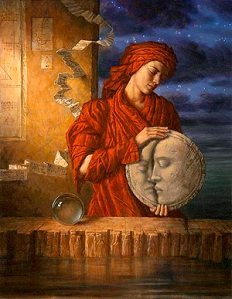 A beautiful modern rendition of Drawing Down the Moon by Jake Baddeley. You can learn more and purchase a copy here.
A beautiful modern rendition of Drawing Down the Moon by Jake Baddeley. You can learn more and purchase a copy here.Drawing Down the Moon
The name of the modern ritual practice of Drawing Down the Moon comes to us from ancient Greece, when it was a known practice of the famous Thessalian witches. The ritual was well known in even the highest intellectual circles of Greek and Roman society. Plato mentions it as do Lucan and Horace.
We have no evidence that the ancient practice was similar to the modern one. The scant clues we do have suggest that it was not. Nonetheless, the modern rite is not without ancient precedent. It is simply to be found somewhere else—in texts, some of which, are roughly contemporary with the height of the activities of the Thessalian witches: the Greco-Egyptian Magical Papyri.
This collection of ancient magical workings is usually known as the Greek Magical Papyri (PGM) because they are written largely in Greek. Nonetheless, scholars are generally agreed that much of the magical technique to be found in them is Egyptian. (Yes, I’m finally getting to Egypt.)
The Greek Magical Papyri provide numerous examples of this technique. One is a working for a sacred vision in which the magician declares they are a prophet about to call upon a powerful name, then they declare that they are the Deity just called upon. Only then, as the Deity, does the magician command Anubis to appear. (PGM VII 319-34 for those of you who want to look it up.)
As I said, we don’t have an Egyptian name for this powerful magical technique. I have called it Kheperu, “Transformations” or “Forms.” The Egyptian root of the word means “to be, to exist, to form, to create, to bring into being, to take the form of someone or something, and to transform oneself.” (Some modern magical Orders call it Taking on the God/dessform.)
 A devotional icon of Hathor by Ptahmassu Nofra-Uaa. You can purchase a print for yourself here.
A devotional icon of Hathor by Ptahmassu Nofra-Uaa. You can purchase a print for yourself here.Recognizing Kheperu
It’s relatively easy to tell when we are witnessing the technique of Kheperu. Most simply, whenever we find the deceased, the priestess, the priest, or the magician claim TO BE a particular Goddess or God and speaks in the first person, we are likely to be witnessing Kheperu. It is the voluntary taking on of the imaginal form of a Deity that enables the ritualist to share, albeit briefly, in the powers and Divine energy of that Deity, usually for the purpose of enhancing the effectiveness of a ritual or for deep communion with that Deity. It is this contact with Divine energy that lends us the power to work our magic.
A clear example comes from a Coffin Text about the Goddess Hathor. The deceased says:
I am in the retinue of Hathor, the most august of the Gods, and She gives me power over my foes who are in the Island of Fire. I have put on the cloak of the Great Lady, and I am the Great Lady. I am not inert, I am not destroyed, and nothing evil will come to pass against me.
The deceased “puts on the cloak”—the imaginal or astral form—of Hathor and becomes Hathor. Doing so enables them to use Her power to protect themselves in the Land of the Dead. Her power, through the deceased who becomes Her, works the magic.
The Egyptian Concept Behind Kheperu
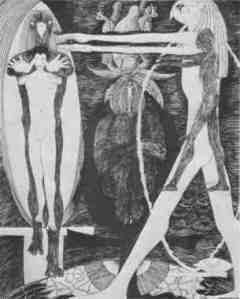 An artistic representation of Kheperu by a modern magician, Steffi Grant
An artistic representation of Kheperu by a modern magician, Steffi GrantThere is a basic idea that must exist in a culture to make it possible for the idea of Kheperu to develop—and that is that human beings are not divorced from the Divine and that they have the ability to become even closer to the Divine.
And indeed, the idea that a human being could be god-like is found throughout Egyptian literature. In the Instruction for Merikare, wisdom literature from the First Intermediate Period, it is said that the deceased is “like a god” in the beyond and refers to humanity as the “likeness of God.” A human being with great knowledge is also said to be a likeness of God.
Deities are inherently godlike, but human beings who wish to partake of godlike powers have to make an extra effort—through ritual actions and by being in accord with Ma’et, “Rightness” or “Truth.” By proper words, deeds, and personal rightness, human beings may participate with the Divine.
For me, the technique of Kheperu is a defining characteristic of Egyptian and Egyptian-derived magic. There are reasons to believe that it was more than a mere invocatory convention to the Egyptians and that a genuine connection with the Deity invoked was both intended and achieved. Kheperu was one of the key ways the ancient Egyptians empowered their spirituality—and it is one of the most important ways we can empower our own spirituality and our relationship with Isis, today.
September 25, 2022
Inanna, Inanna, Inanna!
Nothing new from me today. Just got back from our Fall EQ festival where we had ritual theatre of the whole story of Inanna’s descent (our ritual actors were AHmazing!), trance dancing, wow workshops, SO many offerings, SO much chanting. I hope your equinox was just as wonderful. I’m gonna take a nap.
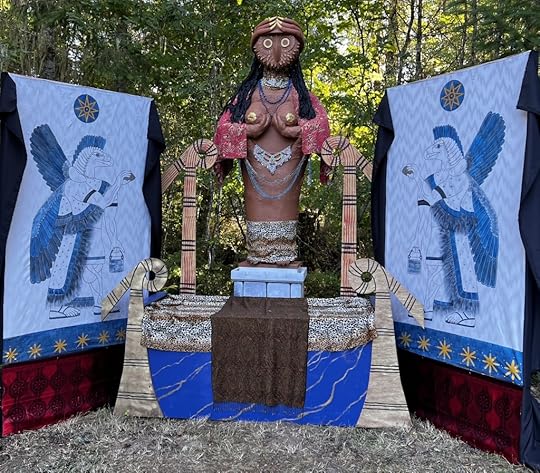 The main altar with our Owl-faced Goddess with Her eagle-faced Guardians. A friend and I painted two sets of these Guardians. Oh, and the Guardian banners are 6 feet tall, so you can see how big the sacred image of Inanna is!
The main altar with our Owl-faced Goddess with Her eagle-faced Guardians. A friend and I painted two sets of these Guardians. Oh, and the Guardian banners are 6 feet tall, so you can see how big the sacred image of Inanna is!
September 18, 2022
The Adma Iset: A Ritual of Offering to Isis
I often find it easier to keep up my spiritual practice when I have something “set,” something specific to do. Like a small ritual that I’ve pretty much got memorized. You, too? If so, then today I’d like to offer you a just such a small ritual. This one is an offering rite. (If you have my Offering to Isis, a version of it is in there. But since I hear those are going for stupid out-of-print prices, here’s a version you can use, and of course, adapt, as you choose. Offering will be republished. I’ll let you know when.)
Adma is one of the (many) Egyptian words for an offering rite. I just liked the sound of this one compared to some of the others, so I adopted it. The ritual is loosely based on Egyptian temple rites, but adapted for a single person instead of a temple-full of folks.
 The Gesture of Adoration
The Gesture of AdorationThe Adma Iset
Ritual Tools: A cup or other vessel of pure water; a censer with charcoal and incense; fire starter for incense; an offering (this can be anything you choose: milk, beer, flowers, a poem, a dance); a small reed mat (such as a table placemat); a shallow tray of sand large enough to place one foot in; a bundle of fresh plants for sweeping the sand. These last two are optional, but are adapted from things they actually did in Egyptian temples. You can do this rite at your altar; I will assume you have a sacred image of Isis on your altar.
Ritual Preparation: Prepare your offering as needed; set the small reed mat on the floor before the altar; place the tray with sand and the fresh plants conveniently to the side.
Purification & Consecration
Sit comfortably before your altar, breathing slowly, clearing your mind. When you are ready, rise, approach the altar of Isis, and bow politely.
Ritualist: (Raising your hands in a gesture of adoration) Isis is all things and all things are Isis.
Take up the cup and elevate it.
Ritualist: (To the Purifying Powers) O, You Souls of Night, Water Dwellers, Purifiers, You of the Pure Water from the Sycamore Tree of Isis, I have come for you. By the Blood, by the Power, by the Magic of Isis, establish yourselves within this vessel!
Lower the cup to heart level. Visualize blue light coming into your body from above, let it move through your body into the earth, then bring it back up into your heart, then into the cup as you vibrate.
Ritualist: (Vibrating) ISET MU!
Circle your ritual space, sprinkling water, then sprinkle yourself.
Ritualist: (Speaking while walking) Isis is pure. The temple is pure. The temple is pure. I am pure. I am pure with the Purity of Isis. I am pure with the Purity of the Goddess. (Repeating until you return to the altar; then repeat as needed until you feel it to be so.)
Ritualist: By the Magic of Isis, it is so!
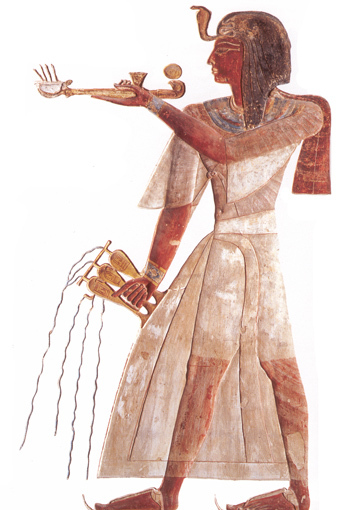 A priest purifying and consecrating
A priest purifying and consecratingReturn cup to altar, take up censer and elevate it.
Ritualist: (To the Consecrating Powers) O, You Souls of Day, Fire Dwellers, Consecrators, You of the Pure Breath from the Mouth of Isis, I have come for you. By the Blood, by the Power, by the Magic of Isis, establish yourselves within this censer!
Lower the censer to heart level. Visualize red light coming into your body from above, let it move through your body into the earth, then bring it back up into your heart, then into the censer as you vibrate.
Ritualist: (Vibrating) ISET ASH!
Circle your ritual space, censing it and then yourself.
Ritualist: (Speaking while walking) Isis is consecrated. The temple is consecrated. The temple is consecrated. I am consecrated. I am consecrated with the Fire of Isis. I am consecrated with the Flame of the Goddess. (Repeating until you return to the altar; then repeat as needed until you feel it to be so.)
Ritualist: By the Magic of Isis, it is so!
Entering
 Opening the Shrine
Opening the ShrineFace the altar and make the Gesture of Adoration.
Ritualist: Isis is upon Her Throne. The spirits awaken! They awaken in peace for they know that I have come to make offering unto this Great Goddess.
Put your palms together and extend your arms straight out in front of you. Slowly open your arms as if opening a heavy curtain. This is the gesture of Opening the Shrine. Place the tray of sand before the sacred image and step in it to leave a footprint in the sand.
Ritualist: The sacred doors are opened to me. The light goes forth. It guides me on a fair path to the place where the Great Goddess is. I approach Your shrine, O Isis.
Offering to the Uraeus Goddess
Take up the censer and elevate it.
Ritualist: (Addressing the Uraeus serpent form of Isis) The Sacred Eye is powerful. Lady of Flame, Great One Who is between the horns of the Sunshine Goddess, accept this perfume and let me enter in peace.
Place the censer in your dominant hand, resting on your upturned palm. Bring that hand to your heart. Breathe in and visualize light glowing around the censer. Slowly swing your arm outward toward the image of the Goddess. Visualize the light flowing from the incense smoke to Her sacred image. This is the Gesture of Giving. Return the censer to its place.
Invoking the Goddess
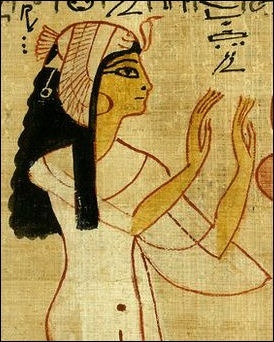 Priestess (or queen) invoking
Priestess (or queen) invokingStand before the sacred image. Place your palms together in front of you as if preparing to applaud. Bring them apart to a comfortable distance, remaining thumbs up. To make the Gesture of Invocation, move the tips of your fingers towards you in a ‘come to me’ gesture. Do this slowly and gently as you speak the invocation below.
Ritualist: Iu en-i. Iu en-i (Eeoou-en-EE). Come to me, come to me, Beautiful, Great One—Isis of Many Names, Lady of Sacred Magic, Great Mother, Great Goddess, come to me, come to me! (Vibrating) ISIS. ISIS. ISIS.
See within your heart the light of the Goddess. Feel it glowing with sun-bright warmth and beauty.
(Speaking to the Goddess) Fair is Your coming to Your temple, Isis. Beautiful is Your appearance in my heart.
Place your hand upon your heart, breathe in, and on the out-breath, move your hand toward the altar and send that light into the sacred image of Isis.
Making Offering
 Offering incense
Offering incenseYou may wish to be seated at this time.
Ritualist: My body being on Earth, my heart being awake, my magic being in my mouth, O Isis, I make offering unto You.
Take up your offering. With open heart, speak aloud why you have chosen to give that particular offering to the Goddess.
If your offering is physical, use the Gesture of Giving (above) to offer it to Isis. If it is not, visualize a symbol representing it in your palm as if it were physical. Breathe in, visualize light around the offering, then on the out-breath, move your hand toward the altar and see that light transfer to the sacred image of Isis. Then, if your offering is performative, perform the offering (e.g. read the poem, dance the dance).
The Reversion of Offerings (optional section)
Stand and make the Gesture of Adoration toward the sacred image of Isis. Visualize the Goddess tracing an ankh symbol over the offering you have given. It glows with the power of Life, the power of Her Divine Ka. She breathes a blessing into them. She breathes a blessing into you. Breathe Her breath.
Ritualist: The offerings are reverted. Their blessing comes to me. Their blessing goes out into the world. Their beauty endures forever.
Note: Offerings such as food and drink, once reverted, may be consumed by you and your household. Non-consumable offerings may be kept on Isis’ altar or kept in some other convenient place nearby.
Closing the Temple
Once again, take some time to see the light of what you have given glowing around the sacred image of Isis. Let yourself KNOW that She has accepted your offering. Feel Her blessing upon you in return.
When you are ready, take up the bundle of plants and sweep away the footprint in the sand. Make the Gesture of the Closing of the Shrine (the opposite of Opening the Shrine above).
Ritualist: I have flourished on water. I have grown on incense. I have climbed up on sunbeams. O Isis, give me Your hand for I have made offering unto You.
Be in peace, Isis, be in peace. Amma, Iset (AH-ma, EE-set; Egyptian: “Grant that it be so, Isis”).
The Adma is finished. Exit the ritual space or remain in meditation as desired.
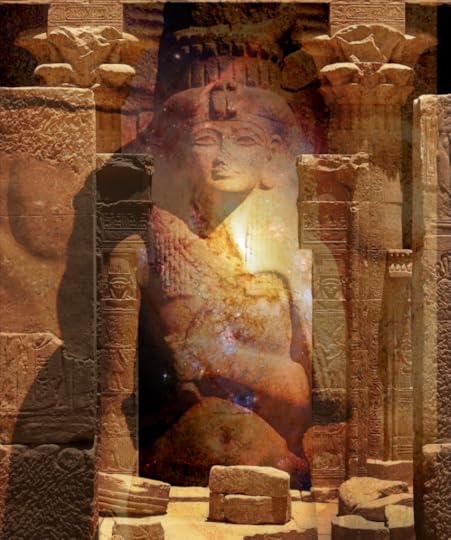 Be in peace, Isis, be in peace. Amma, Iset.
Be in peace, Isis, be in peace. Amma, Iset.



